The Intel Core i3-7350K (60W) Review: Almost a Core i7-2600K
by Ian Cutress on February 3, 2017 8:00 AM ESTLegacy and Synthetic Tests
At AnandTech, I’ve taken somewhat of a dim view to pure synthetic tests, as they fail to be relatable. Nonetheless, our benchmark database spans to a time when that is all we had! We take a few of these tests for a pin with the latest hardware.
Cinebench R10
The R10 version of Cinebench is one of our oldest benchmarks, with data going back more than a few generations. The benchmark is similar to that of the newest R15 version, albeit with a simpler render target and a different strategy for multithreading.
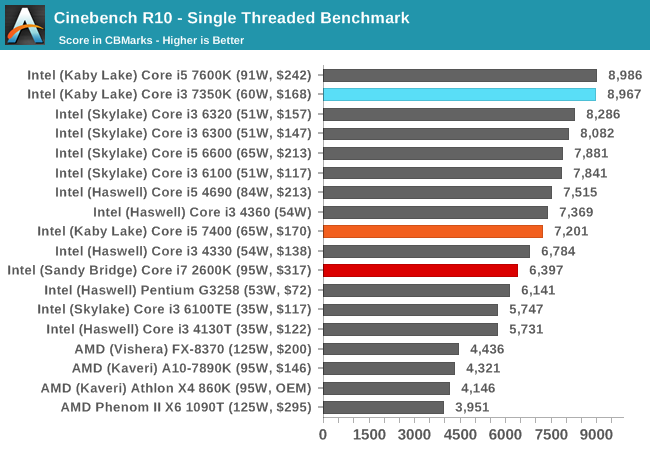
With high frequency in tow, the Core i3-7350K makes its mark.
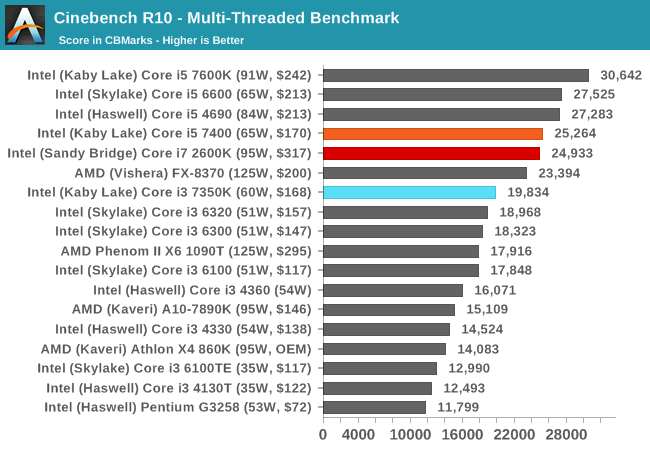
When more threads come to play, the Core i5-7400 and Core i7-2600K battle it out in terms of four cores and IPC vs hyperthreading. The Core i3-7350K sits around ~25% behind.
Cinebench R11.5
CB11.5 has been popular for many years as a performance test, using easy to read and compare numbers that aren’t in the 1000s. We run the benchmark in an automated fashion three times in single-thread and multi-thread mode and take the average of the results.
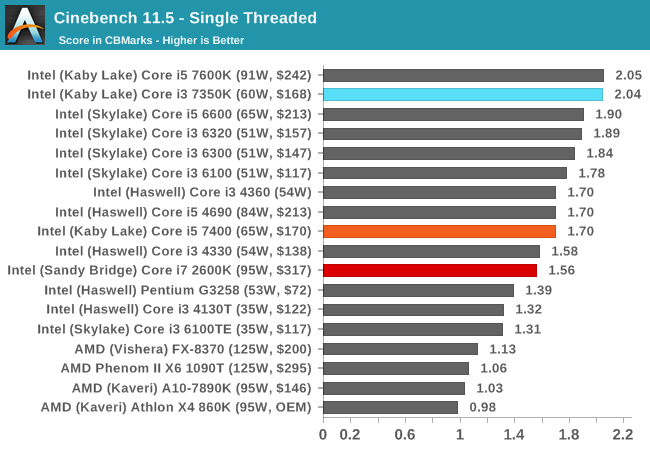
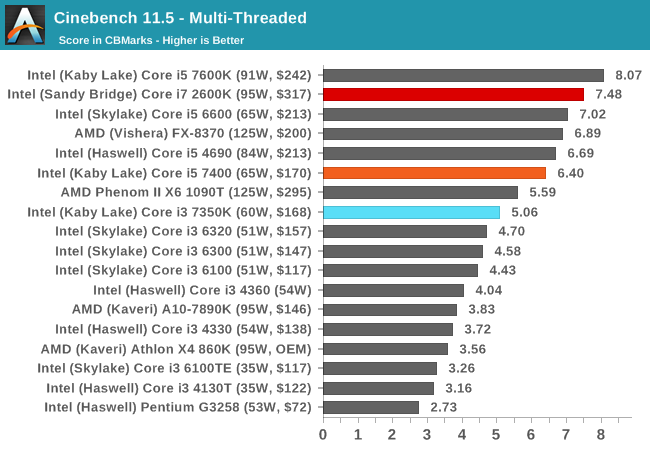
Similar to CB10, the single thread results show that a 4.2 GHz Kaby Lake is nothing to be sniffed at. In the multithreaded test, CB11.5 is more able to leverage the hyperthreads, showing that a Core i7-2600K will run rings around the low end Kaby i5, but is bested by the higher frequency Kaby i5-K. The Core i3 still has that dual core deficit.
7-zip
As an open source compression/decompression tool, 7-zip is easy to test and features a built-in benchmark to measure performance. As a utility, similar to WinRAR, high thread counts, frequency and UPC typically win the day here.
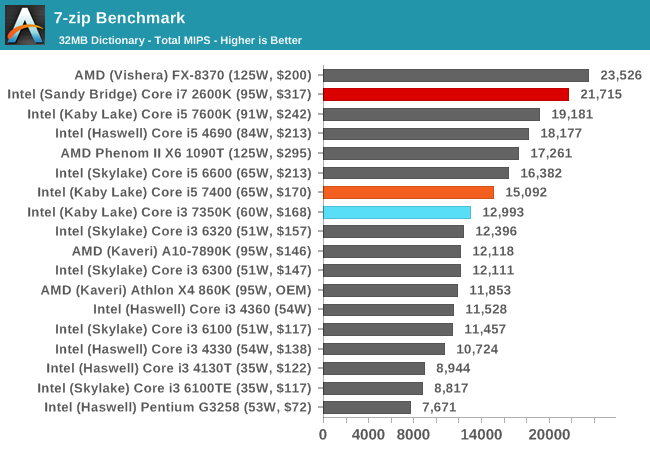
The difference between the i3-7350K and the i5-7400 shows that 7-zip prefers cores over threads, but the Core i7-2600K results show it can use both to good effect, even on older microarchitectures, scoring almost double the i3-7350K.
POV-Ray
Ray-tracing is a typical multithreaded test, with each ray being a potential thread in its own right ensuring that a workload can scale in complexity easily. This lends itself to cores, frequency and IPC: the more, the better.

POV-Ray is a benchmark that is usually touted as liking high IPC, high frequency and more threads. The i7-2600K, despite having double the resources of the Core i3-7350K, is only 30% ahead.
AES via TrueCrypt
Despite TrueCrypt no longer being maintained, the final version incorporates a good test to measure different encryption methodologies as well as encryption combinations. When TrueCrypt was in full swing, the introduction of AES accelerated hardware dialed the performance up a notch, however most of the processors (save the Pentiums/Celerons) now support this and get good speed. The built-in TrueCrypt test does a mass encryption on in-memory data, giving results in GB/s.
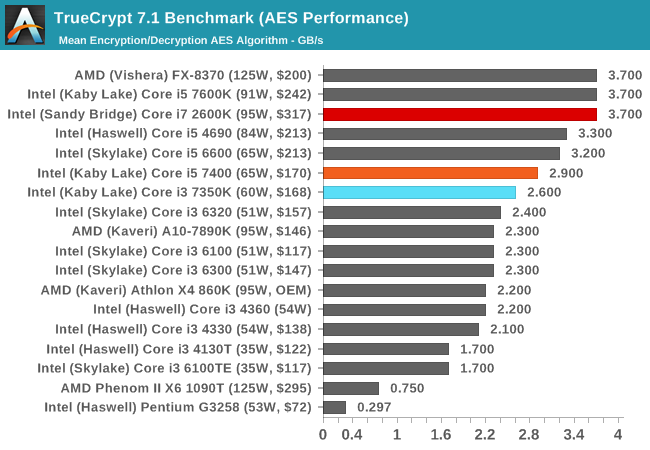










186 Comments
View All Comments
realneil - Wednesday, February 8, 2017 - link
^^This^^Intel is ~finally~ facing some upcoming opposition in the CPU arena and they're trying to fill in some perceived gaps in their CPU lineup.
After Ryzen is released, expect to see multiple product changes from team blue right away to combat AMD's offerings.
CaedenV - Friday, February 3, 2017 - link
I think it will make more sense with next gen parts. I suspect we are watching a shift in the lineup that is slowly rolling out.celeron - duel core
pentium - entry duel core with HT (limited cache/clock/iGPU)
i3 - high-end duel core HT (essentially unchanged)
i5 - quad core with HT (today's i7)
i7 - 6-12 core with HT (today's LGA2011 line)
So why no straight quad core part? Well, 2 reasons.
1) it probably isn't needed. The original i5 parts were just i7s with broken HT cores that were disabled. I imagine most chips coming out now have perfectly fine HT cores, so they are artificially disabled. This increases the cost of the binning process, and reduces profit on a per-chip basis... especially if they can sell the same part somewhere between today's i5 and i7 price.
2) Right now I would wager that most home builders buy either an i3 because they are budget conscious, or i7 because their pride will not let them get anything less than the best. But the i7 that they buy is the lower margin 'consumer' i7 chips rather than the premium laiden LGA2011 i7 chips that make buku bucks on both CPU and chipset sales. Moving the i7 lineup to start at ~$500 instead of ~$280 would more than off-set the number of people willing to step down to an i5 chip; even if the step down is in name only and really the i5 would be more affordable while offering traditionally i7 performance levels.
3) Bonus reason; Ryzen chips are expected to land near today's i5/i7 chips in performance, and Intel does not want AMD to be able to say 'our chips are as fast as an i7 but only cost what an i5 does'. Instead, intel want's it's smug users (like myself) to say 'ya, that Ryzen is not a bad chip, but it doesn't hold a candle to my i7'. Real world benchmarks be damned, it is what people are going to say.
Alexvrb - Friday, February 3, 2017 - link
I wouldn't necessarily bet that more home users buy i7s than i5s. I personally know two gamers that recently built i5 systems because they wanted more oomph than a 2C/4T i3, but didn't want to spend money on an i7. Why? So they could spend more money where it makes the biggest difference... the graphics card. An i5 provides plenty of CPU horsepower for games, and gives you another $100 or so to spend on better graphics.I think their judgement was sound. I doubt they are alone in this kind of assessment. I think you're letting your admitted i7 smugness cloud your judgement a little bit.
Tunnah - Saturday, February 4, 2017 - link
I build PCs for my friends, and advise people on what to buy, and I don't know a single person apart from myself who has an i7 (and only know of 1 person who has an i3 but he uses his box for media). i5 is a perfect chip for casual users who use the PC mostly to game.Hell the only reason I have an i7 is for Civ VI ha.
Alexvrb - Saturday, February 4, 2017 - link
Bingo!Meteor2 - Sunday, February 5, 2017 - link
i7s (or Xeons) are nice if you're encoding a lot of x265 video (x265 gives better quality per bitrate than hardware encoders). That's the only desktop use case I can think of.Meteor2 - Sunday, February 5, 2017 - link
...or apparently not, according to a comment way below, where a 12C/24T Xeon barely does double digit x265 FPS.bak0n - Monday, February 6, 2017 - link
Exactly why I have an I5 3570k. My next build will either be a ryzen (depending on wither it hits expectations), or the I5 of whatever generation is out when I'm ready to buy. To big of a price jump to the I7 for a hard core 1080P maxed setting gamer, but not to much of a price jump over the i3's. That is, until now with the i3k which I may actually give a second look at.DiHydro - Monday, February 6, 2017 - link
I fit into that category with one caveat, I also do some 3d modeling and rendering. This pushed me to the i7-2600k about four years ago, and I still don't feel that my CPU is the limiting factor on my PC.Byte - Saturday, February 4, 2017 - link
Very true, most customers want the best or the cheapest. Changing the lineup liek that would make it easier.